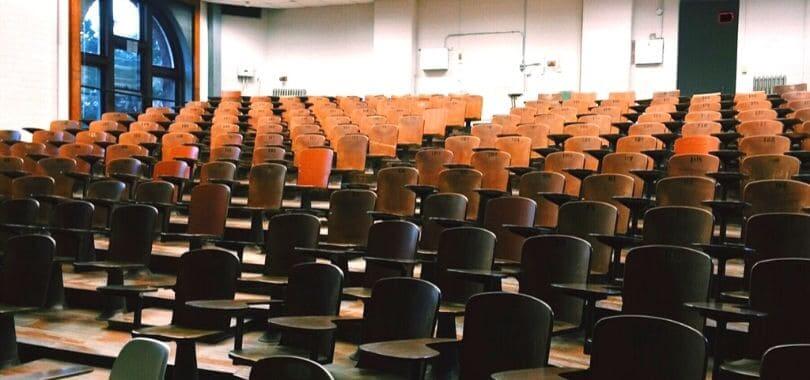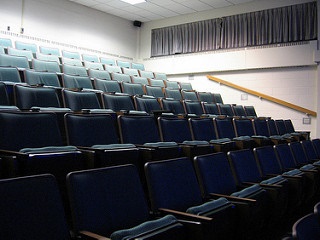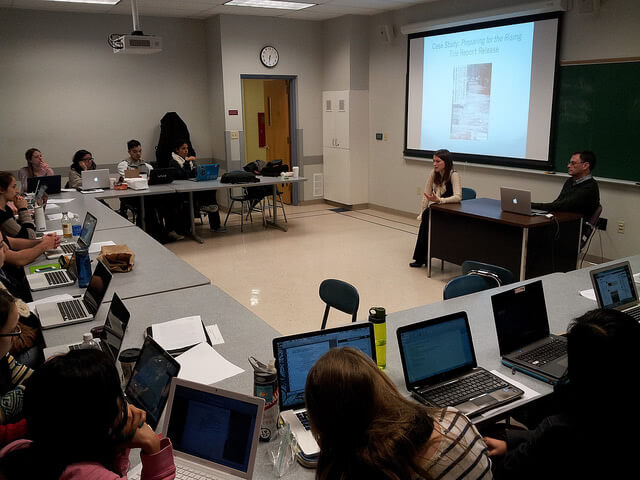Freshman, you’re probably used to high school classes with a max of 35 students. While there will be some courses at college that are similar, you will likely take a lot of lecture classes too. Suddenly you don’t just have 35 classmates, you have 100, or 200, or even 500. Class size will largely depend on how big the college is, of course, but lectures can get pretty large.
The bigger the class, the bigger the classroom. Lecture halls can sometimes feel more like theaters than anything. (My freshman psychology class even had balcony seating in addition to the 600+ seats on the main floor).
When you walk into a big lecture class, one of the first things you might wonder is: where should I sit? There are advantages and disadvantages to every spot in a lecture hall. Different students have different needs or circumstances, and so might pick one area over another.
Let’s go through the different seating spots in a lecture hall and highlight the pros and cons of each.
Pros for the Front Row:
 Attention Grabber
Attention Grabber
If you really want to focus in a class, have a hard time staying awake, or have a tendency to get distracted easily, sit in the front row. Being right in front of a professor tends to keep you engaged.
 Won’t Miss a Thing
Won’t Miss a Thing
Being close to the front means you won’t have a hard time hearing the professor and you won’t have a hard time seeing them or the slide-show. In big lectures, teachers will often use microphones that are hooked up to a sound system, but even then the technology can be spotty and some prefer just to project their voices. If you’re in the front, you don’t have to worry about hearing them, and you’re likely right in front of the projector so you won’t have to squint your eyes to see either.
Cons for the Front Row:
 Prime Pickings
Prime Pickings
It’s unlikely you will be called on in a lecture hall. Since lecture classes are primarily the professor, well, lecturing, there usually isn’t a ton of student participation–and even then, the prof usually chooses someone with their hand raised. Still, there is a slight possibility of being called out during a lecture. (One of my professors would call on students who weren’t paying attention, it was nerve-wracking).
 First Row, Last to Go
First Row, Last to Go
If you’re in the front, it usually means you’ll be one of the last ones out–unless there are additional doors near the front of the room. This may not be an issue unless you have another class in 15 minutes that’s all the way across campus. Then it might be a bit of a scramble.
Pros for the Back Row:
 Escape Route
Escape Route
If you have another class, a job, or other obligations immediately following the lecture, it might be a good idea to sit in the back near the doors. If you need to duck out a few minutes early, being able to sneak out the back won’t be as distracting to your classmates.
 More Relaxed
More Relaxed
If you’re anything like me, sitting in the back eases a lot of stress. You’re not under the spotlight and if you’re in the very back, you’re not completely surrounded by other students. Without the stress of claustrophobia or whatnot, you can focus on the lecture itself.
Cons for the Back Row:
 Daydream Land
Daydream Land
Let’s face it, being in the back where the pressure is lower can lead to your mind wandering. If you’re taking notes on a laptop, you might be tempted to switch over to Facebook or even study for another class. Worse yet, some people in the back of the lecture hall nod off–and even snore!
 Distance
Distance
Many times while adjusting their microphones or raising their voices, professors will ask: “Can you hear me in the back?” Sometimes you can, other times it’s a bit of a strain. That goes for seeing things, too. Whether the professor is putting on a demonstration–say a prof teaching anatomy is pointing to a place on a skeleton–or just showing slides on a projector, being too far away to properly see isn’t going to help you in the long run.
Pros for the Middle:
 Middle of the Pack
Middle of the Pack
Not too close, not too far, just right. Being in the middle can balance out the extremes of the front and back seating, while also leaning on the perks of both. The middle rows will ease you from the stress/expectation of the front, but you’re still close enough to be paying rapt attention to the lecture.
 Most Available Seating
Most Available Seating
The back row is likely to fill up first, followed by the ones closer to the front. That leaves the biggest area to fill: the middle. Even if you’re running a little behind, odds are you can find an open spot.
Cons for the Middle:
 Traffic Jam
Traffic Jam
Being in the middle of the pack means you’re literally in the middle of the pack. During the mass exit of the lecture hall, you’ll be jostled around with your classmates in the scramble to get out. If you don’t have another thing to get to, it’s not a big deal. But be careful if you’ve got a tight schedule.
Whether you’re in the front, back, or middle, you’re going to have to make another decision–do you sit on the side of the row or the center?
Pros for the Center Seats:
 Common Courtesy
Common Courtesy
It’s never fun to climb over a stranger or be climbed over for that matter. By scooting in towards the middle of the row, as much as you can, is just plain polite. It certainly beats stepping on toes or backpacks or having your stuff and feet stepped on.
 Space to Stretch
Space to Stretch
People tend to prefer sitting on the sides, so you might find more space in the center of a row. College is a great time to meet new people, but sometimes during class, you just want to focus and have a little space for yourself. Parking in the middle might give you that space.
Cons for the Center Seats:
 Traffic Jam: Part Two
Traffic Jam: Part Two
Like with the middle seats, the center seats have the same problem of being caught in the bulk of the exiting crowd. Worse yet–if you sit in the middle area, in the center of the row. You’re likely to be the last one out of the hall.
 All Eyes on You (Sort Of)
All Eyes on You (Sort Of)
Sitting in the center means having classmates on all sides–front, back, left, right. Even though people will be (or should be) focused on the professor at the front of the room, sometimes it can feel as if you’re being surrounded.
Pros for the Side Seats:
 Escape Route: Part Two
Escape Route: Part Two
Many prefer the sides of the rows for a quick and easy exit. College life is busy, and every minute counts. Sitting on the side eliminates the need to shuffle at a slow pace after the person sitting next to you to get out.
 Less Claustrophobic
Less Claustrophobic
Some people just don’t like being in a crowd. Sitting on the aisle seat allows them some breathing room. If you’re one of these people, try to get to class early as the aisle seats are a hot commodity.
Cons for the Side Seats:
 Jungle Gym
Jungle Gym
If you like the side seats, get used to being climbed over. It’s an undeniable likelihood of a lecture class. Make sure you get your bag out of the way or even stand up to let a classmate pass. If you choose the side seats, don’t get grumpy when someone squeezes past you–you chose to sit there, after all.
 Focus or Lack Thereof
Focus or Lack Thereof
If you’re sitting in the aisle for a quick getaway, you might be more focused on getting out of the lecture hall than actually focus on the class itself. The aisle can be liberating, but with that freedom comes daydreaming or misguided focus.
—
The best place in a lecture has a whole bunch of factors: the student, the schedule, the classmates, and the type of class it is. For the first few weeks experiment with your seating arrangement and see what works best for you!







